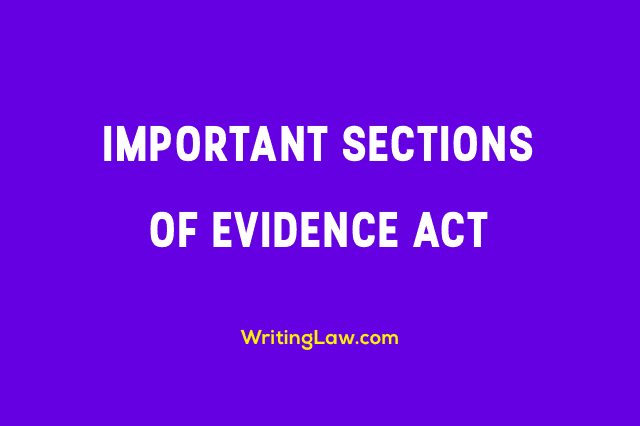
When you are preparing for law exams, it is vital to have a list of the most important sections of that subject. Indian Evidence Act is one of the essential subjects that you have to study for nearly all legal exams and advocacy. To help you quickly revise and focus your time correctly, here is a list of important and useful sections of the Evidence Act.
Important Sections of the Indian Evidence Act
Section 3 – Interpretation Clause.
Section 4 – May Presume.
Section 5 – Evidence may be given of facts in issue and relevant facts.
Section 6 – Relevancy of facts forming part of same transaction.
Section 7 – Facts which are occasion, cause or effect of facts in issue.
Section 8 – Motive preparation and previous or subsequent conduct.
Section 9 – Facts necessary to explain or introduce relevant facts.
Section 10 – Things said or done by conspirator in reference to common design.
Section 11 – When Facts not otherwise relevant become relevant.
Section 14 – Facts showing existence of state of mind or of body or bodily feeling.
Section 15 – Facts bearing on question whether act was accidental or intentional.
Section 17 – Admission defined.
Section 21 – Proof of admission against persons making them, and by or on their behalf.
Section 22A – When oral admissions as to contents of electronic records are relevant.
Section 24 – Confession by inducement, threat or promise when irrelevant in criminal proceeding.
Section 25 – Confession to police officer not to be proved.
Section 26 – Confession by accused while in custody of police not to be proved against him.
Section 27 – How much of information received from accused may be proved.
Section 28 – Confession made after removal of impression caused by inducement, threat or promise, relevant.
Section 31 – Admissions not conclusive proof but may estop.
Section 32 – Case in which statement of relevant fact by person who is dead or cannot be found, etc is relevant.
Section 40 to Section 44 – Judgments of Courts of Justice, When Relevant.
Section 45 – Opinions of experts.
Section 47 – Opinions as to handwriting when relevant.
Section 51 – Grounds of opinion when relevant.
Section 52 to Section 55 – Character When Relevant.
Section 56 to Section 58 – Facts Which Need Not be Proved.
Section 59 – Proof of facts by oral evidence.
Section 60 – Oral evidence must be direct.
Section 62 – Primary evidence.
Section 63 – Secondary Evidence.
Section 65 – Cases in which secondary evidence relating to documents may be given.
Section 65B – Admissibility of electronic records.
Section 74 – Public documents.
Section 75 – Private documents. (Difference between Public and Private Documents.)
Section 90 – Presumption as to documents thirty years old.
Section 91 – Evidence of terms of contracts, grant and other dispositions of property reduced to form of documents.
Section 110 – Burden of proof as to ownership.
Section 111 – Proof of good faith in transactions where one party is in relation of active confidence.
Section 111A – Presumption as to certain offences.
Section 112 – Birth during marriage, conclusive proof of legitimacy.
Section 113 – Proof of cession of territory.
Section 113A – Presumption as to abetment of suicide by a married women.
Section 113B – Presumption as to dowry death.
Section 114 – Court may presume existence of certain facts.
Section 114A – Presumption as to absence of consent in certain prosecutions for rape.
Section 115 to Section 117 – Estoppel.
Section 118 – Who may testify?
Section 119 – Witness unable to communicate verbally/Dumb witness.
Section 122 – Communications during marriage.
Section 123 – Evidence as to affairs of State.
Section 124 – Official communications.
Section 132 – Witness not excused from answering on ground that answer will criminate.
Section 133 – Accomplice.
Section 134 – Number of witnesses.
Section 137 – Examination-in-chief.
Section 141 – Leading questions.
Section 142 – When they must not be asked.
Section 143 – When they must be asked.
Section 145 – Cross-examination as to previous statements in writing.
Section 151 – Indecent and scandalous questions.
Section 157 – Former statements of witness may be proved to corroborate later testimony as to same fact.
Section 159 – Refreshing memory.
Section 167 – No new trail for improper admission or rejection of evidence.
Evidence Act Sections for Exams
These were the most important sections of the Indian Evidence Act. You may devote maximum time to these and slightly less to others. But before you discard the rest, understand that if your syllabus demands, then the sections not listed here may also be relevant and necessary.
Read Next: 10 Recent and Landmark Case Laws for Dying Declaration
- Article 334A of the Constitution of India - 14th April 2024
- Article 332A of the Constitution of India - 14th April 2024
- Article 330A of the Constitution of India - 14th April 2024







